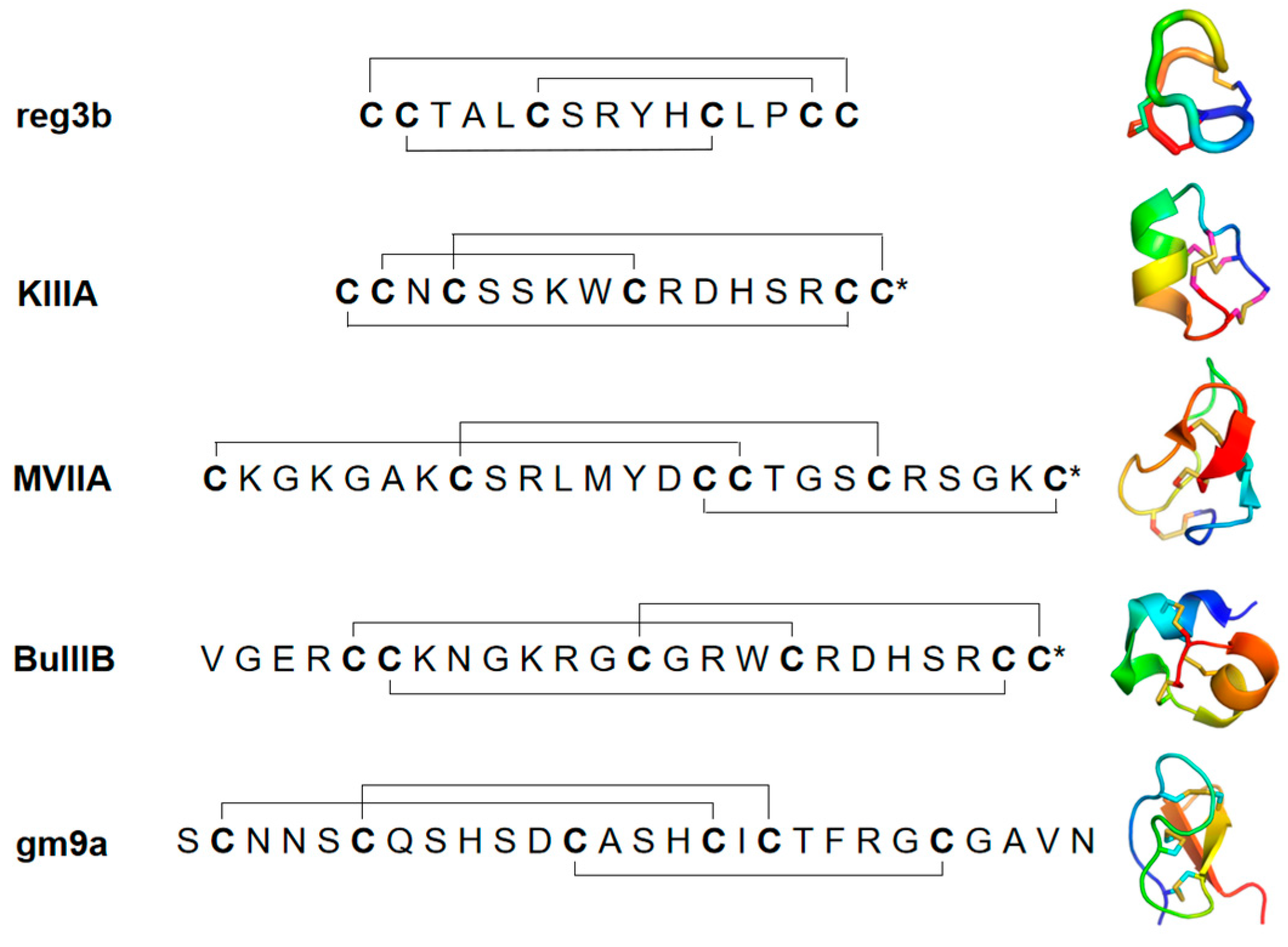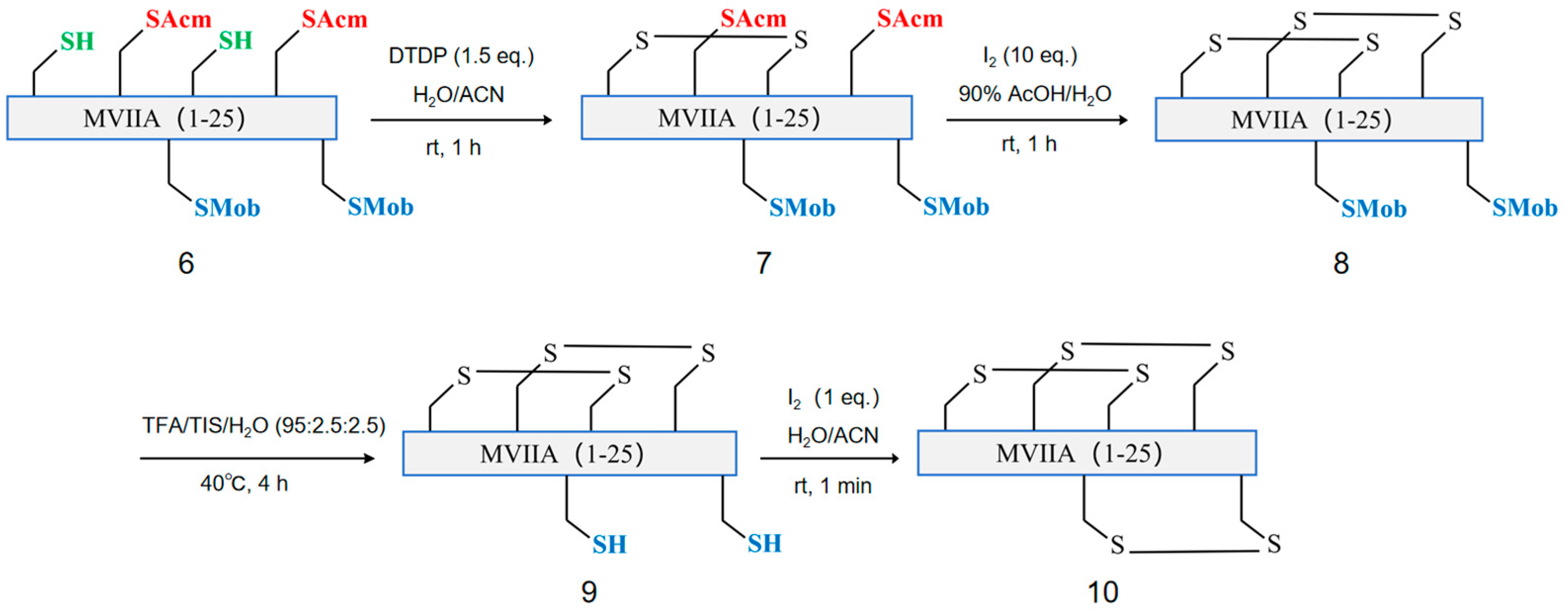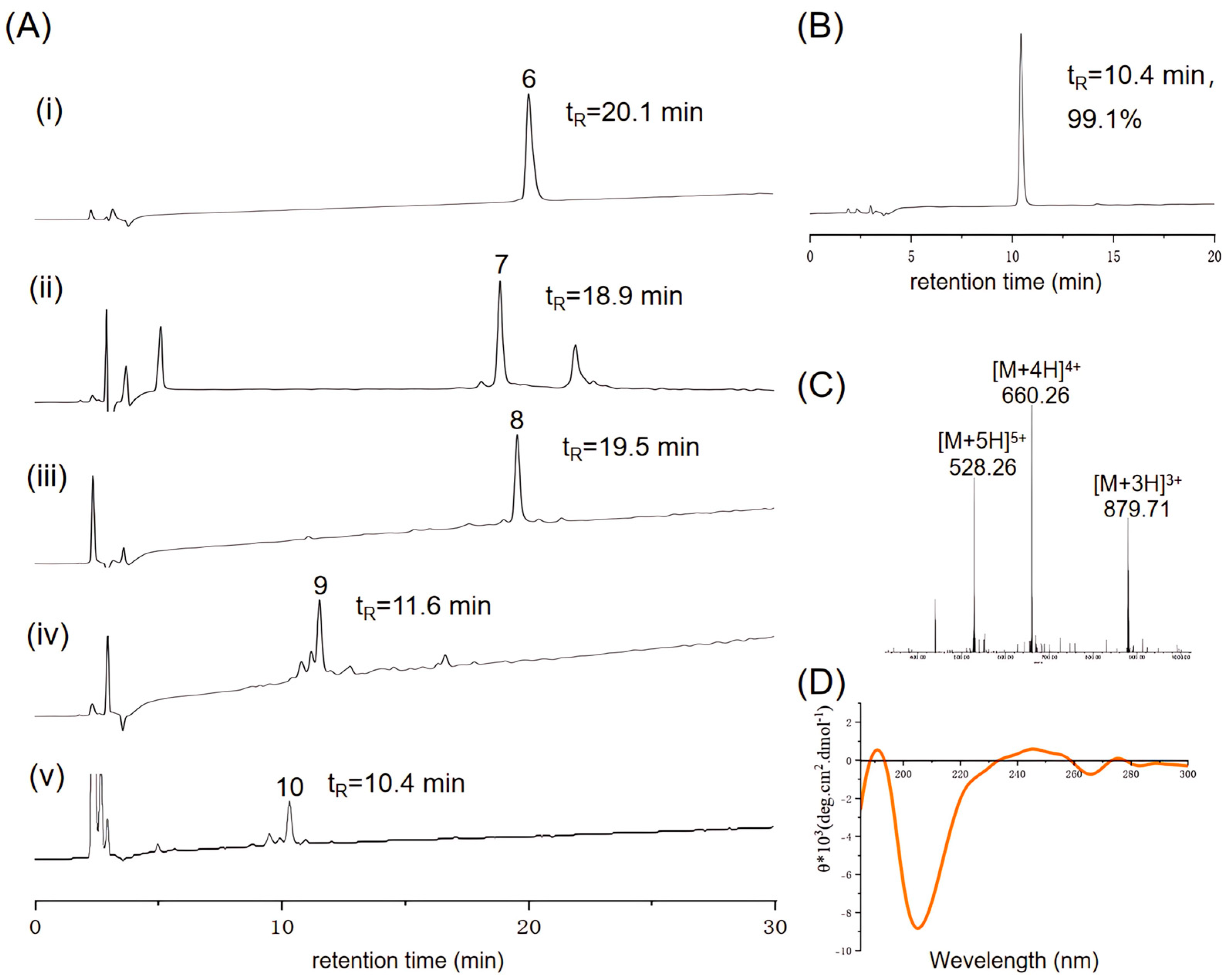An Orthogonal Protection Strategy for the Synthesis of Conotoxins Containing Three Disulfide Bonds
Abstract
:1. Introduction
2. Results and Discussion
2.1. S-Mob Deprotection Conditions
2.2. Synthesis of Conotoxin reg3b
2.3. Synthesis of Conotoxin MVIIA
2.4. Comparisons of Secondary Hα Chemical Shifts
2.5. Application to the Other Three Conotoxins
3. Materials and Methods
3.1. General Information
3.2. Synthesis of Linear Peptides
3.3. Oxidative Folding of Peptides
3.4. Circular Dichroism (CD)
3.5. NMR Spectroscopy
4. Conclusions
Supplementary Materials
Author Contributions
Funding
Institutional Review Board Statement
Data Availability Statement
Conflicts of Interest
Abbreviations
| SPPS | Solid-phase peptide synthesis |
| HCTU | 5-Chloro-1-[bis(dimethylamino)methylene]-1H-benzotriazolium 3-oxide hexafluorophosphate |
| DIEA | N,N-Diisopropylethylamine |
| DTDP | 4,4′-Dipyridyl disulfide |
| Trt | Trityl |
| Acm | Acetamidomethyl |
| Mob | 4-Methoxybenzyl |
References
- Hone, A.J.; McIntosh, J.M. Nicotinic acetylcholine receptors: Therapeutic targets for novel ligands to treat pain and inflammation. Pharmacol. Res. 2023, 190, 106715. [Google Scholar] [CrossRef] [PubMed]
- Carstens, B.B.; Clark, R.J.; Daly, N.L.; Harvey, P.J.; Kaas, Q.; Craik, D.J. Engineering of conotoxins for the treatment of pain. Curr. Pharm. Des. 2011, 17, 4242–4253. [Google Scholar] [CrossRef]
- Li, X.; Tae, H.S.; Chu, Y.; Jiang, T.; Adams, D.J.; Yu, R. Medicinal chemistry, pharmacology, and therapeutic potential of α-conotoxins antagonizing the α9α10 nicotinic acetylcholine receptor. Pharmacol. Ther. 2021, 222, 107792. [Google Scholar] [CrossRef]
- Jin, A.H.; Muttenthaler, M.; Dutertre, S.; Himaya, S.W.A.; Kaas, Q.; Craik, D.J.; Lewis, R.J.; Alewood, P.F. Conotoxins: Chemistry and Biology. Chem. Rev. 2019, 119, 11510–11549. [Google Scholar] [CrossRef] [PubMed]
- Prommer, E. Ziconotide: A new option for refractory pain. Drugs Today 2006, 42, 369–378. [Google Scholar] [CrossRef]
- Yu, R.; Seymour, V.A.; Berecki, G.; Jia, X.; Akcan, M.; Adams, D.J.; Kaas, Q.; Craik, D.J. Less is More: Design of a Highly Stable Disulfide-Deleted Mutant of Analgesic Cyclic α-Conotoxin Vc1.1. Sci. Rep. 2015, 5, 13264. [Google Scholar] [CrossRef] [PubMed]
- Khoo, K.K.; Gupta, K.; Green, B.R.; Zhang, M.M.; Watkins, M.; Olivera, B.M.; Balaram, P.; Yoshikami, D.; Bulaj, G.; Norton, R.S. Distinct disulfide isomers of μ-conotoxins KIIIA and KIIIB block voltage-gated sodium channels. Biochemistry 2012, 51, 9826–9835. [Google Scholar] [CrossRef]
- Tabassum, N.; Tae, H.S.; Jia, X.; Kaas, Q.; Jiang, T.; Adams, D.J.; Yu, R. Role of CysI-CysIII Disulfide Bond on the Structure and Activity of α-Conotoxins at Human Neuronal Nicotinic Acetylcholine Receptors. ACS Omega 2017, 2, 4621–4631. [Google Scholar] [CrossRef]
- Cuthbertson, A.; Indrevoll, B. Regioselective formation, using orthogonal cysteine protection, of an alpha-conotoxin dimer peptide containing four disulfide bonds. Org. Lett. 2003, 5, 2955–2957. [Google Scholar] [CrossRef]
- Ramming, T.; Appenzeller-Herzog, C. The physiological functions of mammalian endoplasmic oxidoreductin 1: On disulfides and more. Antioxid Redox Signal 2012, 16, 1109–1118. [Google Scholar] [CrossRef]
- Akaji, K.; Tatsumi, T.; Yoshida, M.; Kimura, T.; Fujiwara, Y.; Kiso, Y. Disulfide bond formation using the silyl chloride-sulfoxide system for the synthesis of a cystine peptide. J. Am. Chem. Soc. 1992, 114, 4137–4143. [Google Scholar] [CrossRef]
- Dekan, Z.; Mobli, M.; Pennington, M.W.; Fung, E.; Nemeth, E.; Alewood, P.F. Total synthesis of human hepcidin through regioselective disulfide-bond formation by using the safety-catch cysteine protecting group 4,4′-dimethylsulfinylbenzhydryl. Angew. Chem. Int. Ed. Engl. 2014, 126, 2975–2978. [Google Scholar] [CrossRef]
- Góngora-Benítez, M.; Tulla-Puche, J.; Paradís-Bas, M.; Werbitzky, O.; Giraud, M.; Albericio, F. Optimized Fmoc solid-phase synthesis of the cysteine-rich peptide linaclotide. Biopolymers 2011, 96, 69–80. [Google Scholar] [CrossRef]
- Wang, S.; Zhou, Q.; Li, Y.; Wei, B.; Liu, X.; Zhao, J.; Ye, F.; Zhou, Z.; Ding, B.; Wang, P. Quinoline-Based Photolabile Protection Strategy Facilitates Efficient Protein Assembly. J Am Chem Soc. 2022, 144, 1232–1242. [Google Scholar] [CrossRef]
- Laps, S.; Atamleh, F.; Kamnesky, G.; Sun, H.; Brik, A. General synthetic strategy for regioselective ultrafast formation of disulfide bonds in peptides and proteins. Nat. Commun. 2021, 12, 870. [Google Scholar] [CrossRef]
- Akabori, S.; Sakakibara, S.; Shimonishi, Y.; Nobuhara, Y. A new method for the protection of the sulfhydryl group during peptide synthesis. Bull. Chem. Soc. Jpn. 1964, 37, 433–434. [Google Scholar] [CrossRef]
- Schroll, A.L.; Hondal, R.J.; Flemer, S., Jr. 2, 2′-Dithiobis (5-nitropyridine)(DTNP) as an effective and gentle deprotectant for common cysteine protecting groups. J. Pept. Sci. 2012, 18, 1–9. [Google Scholar] [CrossRef] [PubMed]
- Marie, E.J.S.; Hondal, R.J. Reduction of cysteine-S-protecting groups by triisopropylsilane. J. Pept. Sci. 2018, 24, e3130. [Google Scholar] [CrossRef] [PubMed]
- Zheng, N.; Karra, P.; VandenBerg, M.A.; Kim, J.H.; Webber, M.J.; Holland, W.L.; Chou, D.H.C. Synthesis and characterization of an A6-A11 methylene thioacetal human insulin analogue with enhanced stability. J. Med. Chem. 2019, 62, 11437–11443. [Google Scholar] [CrossRef]
- Góngora-Benítez, M.; Mendive-Tapia, L.; Ramos-Tomillero, I.; Breman, A.C.; Tulla-Puche, J.; Albericio, F. Acid-labile Cys-protecting groups for the Fmoc/tBu strategy: Filling the gap. Org. Lett. 2012, 14, 5472–5475. [Google Scholar] [CrossRef]
- Barlos, K.; Gatos, D.; Hatzi, O.; Koch, N.; Koutsogianni, S. Synthesis of the very acid-sensitive Fmoc-Cys(Mmt)-OH and its application in solid-phase peptide synthesis. Int. J. Pept. Protein Res. 1996, 47, 148–153. [Google Scholar] [CrossRef]
- King, D.S.; Fields, C.G.; Fields, G.B. A cleavage method which minimizes side reactions following Fmoc solid phase peptide synthesis. Int. J. Pept. Protein Res. 1990, 36, 255–266. [Google Scholar] [CrossRef]
- Franco, A.; Dovell, S.; Möller, C.; Grandal, M.; Clark, E.; Marí, F. Structural plasticity of mini-M conotoxins–expression of all mini-M subtypes by Conus regius. FEBS J. 2018, 285, 887–902. [Google Scholar] [CrossRef] [PubMed]
- Nielsen, K.J.; Thomas, L.; Lewis, R.J.; Alewood, P.F.; Craik, D.J. A consensus structure for omega-conotoxins with different selectivities for voltage-sensitive calcium channel subtypes: Comparison of MVIIA, SVIB and SNX-202. J. Mol. Biol. 1996, 263, 297–310. [Google Scholar] [CrossRef] [PubMed]
- Price-Carter, M.; Gray, W.R.; Goldenberg, D.P. Folding of ω-conotoxins. 2. Influence of precursor sequences and protein disulfide isomerase. Biochemistry 1996, 35, 15547–15557. [Google Scholar] [CrossRef] [PubMed]
- Kim, J.I.; Ohtake, A.; Sato, K. Circular dichroism spectra of calcium channel antagonist ω-conotoxins. Biochem. Biophys. Res. Commun. 1997, 230, 133–135. [Google Scholar] [CrossRef]
- Basus, V.J.; Nadasdi, L.; Ramachandran, J.; Miljanich, G.P. Solution structure of omega-conotoxin MVIIA using 2D NMR spectroscopy. FEBS Lett. 1995, 370, 163–169. [Google Scholar] [CrossRef]
- Amblard, M.; Fehrentz, J.A.; Martinez, J.; Subra, G. Methods and protocols of modern solid phase Peptide synthesis. Mol. Biotechnol. 2006, 33, 239–254. [Google Scholar] [CrossRef]
- Behrendt, R.; White, P.; Offer, J. Advances in Fmoc solid-phase peptide synthesis. J. Pept. Sci. 2016, 22, 4–27. [Google Scholar] [CrossRef]
- Wishart, D.S.; Bigam, C.G.; Yao, J.; Abildgaard, F.; Dyson, H.J.; Oldfield, E.; Markley, J.L.; Sykes, B.D. 1H, 13C and 15N chemical shift referencing in biomolecular NMR. J. Biomol. NMR 1995, 6, 135–140. [Google Scholar] [CrossRef]
- Mohan, M.K.; Abraham, N.; Jayaseelan, B.F.; Ragnarsson, L.; Lewis, R.J.; Sarma, S.P. Structure and allosteric activity of a single-disulfide conopeptide from Conus zonatus at human α3β4 and α7 nicotinic acetylcholine receptors. J. Biol. Chem. 2020, 295, 7096–7112. [Google Scholar] [CrossRef] [PubMed]
- Lin, J.; Chen, S.; Butt, U.D.; Yan, M.; Wu, B. A comprehensive review on ziconotide. Heliyon 2024, 10, e31105. [Google Scholar] [CrossRef] [PubMed]
- Zhao, Z.; Pan, T.; Chen, S.; Harvey, P.J.; Zhang, J.; Li, X.; Yu, R. Design, synthesis, and mechanism of action of novel μ-conotoxin KIIIA analogues for inhibition of the voltage-gated sodium channel Nav1.7. J. Biol. Chem. 2023, 299, 103068. [Google Scholar] [CrossRef] [PubMed]
- Holford, M.; Zhang, M.M.; Gowd, K.H.; Azam, L.; Green, B.R.; Watkins, M.; Olivera, B.M. Pruning nature: Biodiversity-derived discovery of novel sodium channel blocking conotoxins from Conus bullatus. Toxicon 2009, 53, 90–98. [Google Scholar] [CrossRef]
- Miles, L.A.; Dy, C.Y.; Nielsen, J.; Barnham, K.J.; Hinds, M.G.; Olivera, B.M.; Norton, R.S. Structure of a novel P-superfamily spasmodic conotoxin reveals an inhibitory cystine knot motif. J. Biol. Chem. 2002, 277, 43033–43040. [Google Scholar] [CrossRef]








| Entry | Experimental Conditions | Recovery Yield (%) a |
|---|---|---|
| 1 | TFA, 1 h at 40 °C | 71 |
| 2 | TFA/H2O (95:5 v:v), 1 h at 40 °C | 72 |
| 3 | TFA/TIS/H2O (95:2.5:2.5 v:v:v), 1 h at 40 °C | 16 |
| 4 | TFA/thioanisole/H2O (95:2.5:2.5 v:v:v), 1 h at 40 °C | 22 |
| 5 | TFA/TIS/H2O (95:2.5:2.5 v:v:v), 3 h at 40 °C | 3 |
| 6 | TFA/thioanisole/H2O (95:2.5:2.5 v:v:v), 3 h at 40 °C | 4 |
| 7 | Reagent K, 2 h at RT | 88 |
| 8 | Iodine, 1 h at RT | 97 |
Disclaimer/Publisher’s Note: The statements, opinions and data contained in all publications are solely those of the individual author(s) and contributor(s) and not of MDPI and/or the editor(s). MDPI and/or the editor(s) disclaim responsibility for any injury to people or property resulting from any ideas, methods, instructions or products referred to in the content. |
© 2025 by the authors. Licensee MDPI, Basel, Switzerland. This article is an open access article distributed under the terms and conditions of the Creative Commons Attribution (CC BY) license (https://creativecommons.org/licenses/by/4.0/).
Share and Cite
Zhang, H.; Chan, L.Y.; Zhang, H.; Jiang, T.; Craik, D.J.; Cai, W.; Yu, R. An Orthogonal Protection Strategy for the Synthesis of Conotoxins Containing Three Disulfide Bonds. Mar. Drugs 2025, 23, 168. https://doi.org/10.3390/md23040168
Zhang H, Chan LY, Zhang H, Jiang T, Craik DJ, Cai W, Yu R. An Orthogonal Protection Strategy for the Synthesis of Conotoxins Containing Three Disulfide Bonds. Marine Drugs. 2025; 23(4):168. https://doi.org/10.3390/md23040168
Chicago/Turabian StyleZhang, Hengyu, Lai Yue Chan, Huanhuan Zhang, Tao Jiang, David J. Craik, Wenqing Cai, and Rilei Yu. 2025. "An Orthogonal Protection Strategy for the Synthesis of Conotoxins Containing Three Disulfide Bonds" Marine Drugs 23, no. 4: 168. https://doi.org/10.3390/md23040168
APA StyleZhang, H., Chan, L. Y., Zhang, H., Jiang, T., Craik, D. J., Cai, W., & Yu, R. (2025). An Orthogonal Protection Strategy for the Synthesis of Conotoxins Containing Three Disulfide Bonds. Marine Drugs, 23(4), 168. https://doi.org/10.3390/md23040168







